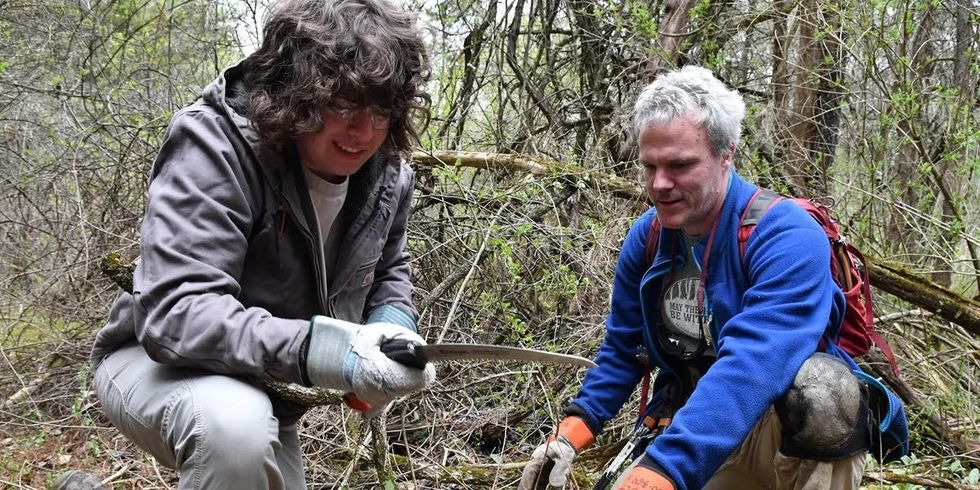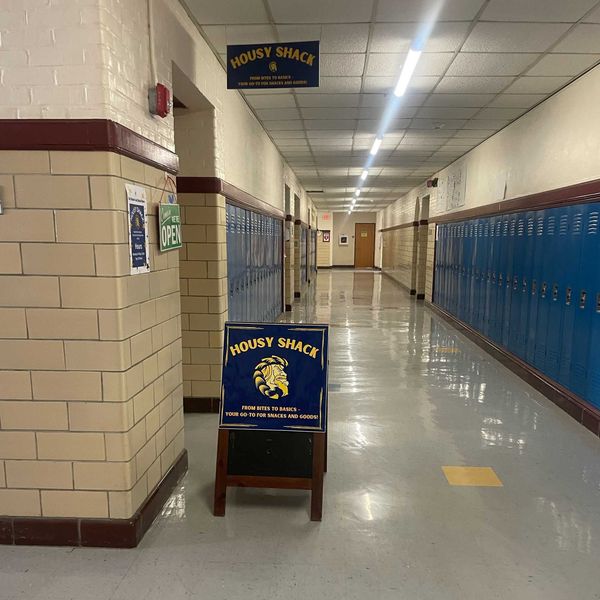Books and backwoods with Tim Hunter

Tim Hunter, right, stewardship director of The Sharon Land Trust giving pointers to a Hotchkiss student.
John Coston

Tim Hunter, right, stewardship director of The Sharon Land Trust giving pointers to a Hotchkiss student.
‘What Are You Reading?” explores the lives of our local community through the books they love. In this first installment, we meet Tim Hunter, Stewardship Director of the Sharon Land Trust, whose passion for nature and science fiction reveals the deep connections between landscape, leadership, and imagination.
Stewardship director ofThe Sharon Land Trust, Tim Hunter monitors, maintains, preserves, and protects approximately 4,000 acres of land held in perpetuity with the organization.
Nature has always been a part of Hunter’s story. “When things got too tough, when things got too loud, I’d always take some time and walk in the woods,” Hunter said. “The outdoors has always been my quiet, happy place.”
After graduating from college with a computer science degree, however, Tim Hunter joined his family’s Sharon-based company Magnamusic Distributors, importing sheet music and instruments. He soon became president of the company, where his work involved setting up computer systems, traveling internationally, and shaking hands with vendors and customers. After six years, though, the family sold the company leaving Hunter to wonder what was next.
As luck would have it, due to his computer science expertise and experience in nature, The Sharon Land Trust reached out, requesting his assistance in mapping out a trail system using geographic information systems (GIS). Hunter embraced this unfamiliar territory and built a trail on the back of Red Mountain, along White Hollow Road, as a connector between the Hamlet and Mary Moore preserve.
Hunter does not work alone. There are two other staff members: Carolyn Klocker, Executive Director, and Harry White, Conservation Director. The magic of The Sharon Land Trust is that almost 90% of the work is volunteer based. About 60 - 70 volunteers join Hunter in the woods for workdays where they do everything from removing invasive species to building and maintaining trails. Most importantly they have fun.
Hunter expressed his gratitude by saying, “We would not be where we are today without them. It’s pretty extraordinary just how much the community does to help us to continue our mission.”
After a day of work, Hunter reads for about an hour before bed. Often, he leans toward science fiction or archaeological novels. Currently he is reading “The Pendergast Series,” a bestselling thriller/mystery book series by Douglas Preston and Lincoln Child. These stories, like the woods, are a wonderful distraction from the human world.
Interested in volunteering with The Sharon Land Trust? Contact: info@sharonlandtrust.org
Olivia Geiger is an MFA student at Western Connecticut State Universiry and a lifelong resident of Lakeville.
The Community Closet at HVRHS is open for students to take clothes for any reason during the school day.
What started with one unexpected donation of clothes has grown into a quietly impactful resource for all students at HVRHS: the Community Closet. Now located in a spacious area above the cafeteria, the closet offers free clothing to any student for any reason.
The idea began a few years ago when a community member reached out to the former superintendent wondering if anyone at the school could benefit from used clothing that would otherwise go to waste. The superintendent then got in contact with Rachel Novak, the school social worker. “Once I had all those bags of clothes in my room, I was like, ‘I should put this in a space,’” Novak said. Her simple idea eventually became a full-sized closet accessible to all students.
From the beginning, Novak envisioned the closet as an inclusive space. “It’s open to anybody, it’s not just based on economic needs,” she said. Sustainability also plays a role. “Thinking about the environment, some students like to thrift and just get clothes that way,” Novak said.
After the initial donation, contributions continued to grow. “I reached out to our staff members and faculty,” Novak said. The most consistent donations come from the faculty at HVRHS and a few community members who learned about the closet. Finding teenage-appropriate clothes has been a challenge. “I get a lot of donations that are nice, but I don’t think teenagers would want to wear them,” Novak said.
Another ongoing obstacle has been awareness. Many students don’t know the closet exists at all. “That’s been the hard part,” Novak said. “Getting it out to the wider community of the school.” Novak is looking for students and staff to spread the word. “It helps because our school nurse knows and other faculty members,” she said. “When they know a student needs something, they just bring them up.”
Looking ahead, she hopes to promote the space more actively. “When we come back from this break, I do plan to … get fliers and all that up and going,” Novak said. There may even be an upcoming expansion — she has discussed the possibility of turning part of the area into a food pantry. “That would be more of a need-based system for students,” she said. “But right now, promoting it is where I’m at.”
The Community Closet is well-stocked currently. “Just because of the amount of clothes I have, I’m not accepting any more donations until I clear some stuff out,” Novak said. She is still willing to make room for more fashionable, teen-friendly items donated by students. “That way I’ll have more teenager approved clothes.”
Above all, she wants students to know that no one is limited to using the space. “Sometimes there’s a stigma around it … like, ‘I don’t need help. I don’t want to take away from anybody else that may need it,’” Novak said. Due to the amount of clothes, students should feel welcome to use the closet for any reason. Some students even grab items last minute for sports and activities. “It’s important for kids to know it’s for everyone.”
Whether a student wants to thrift clothes sustainably, forgot to pack clothes for an after-school practice, or is in need of a new outfit, the Community Closet is a resource for all.
Sophomore Eliana Lang enjoys her Housy Shack cookie.
Now in its second year, the Housy Shack is a hit among students. The special education department-run store that sells warm cookies, drinks and other snacks to students and teachers draws people to a room in the back hallway every time it’s open.
The smell of warm cookies welcomes visitors to the store with snacks, drinks and even Housy merchandise for sale. The cookies are definitely the favorite, sometimes lines go out the door to get one before they sell out.
The cookies are so popular that the store had to increase prices from 50 cents to a dollar and implement a four cookie per person maximum. The Shack sells about 40-100 cookies per day and has about 20-60 HVRHS customers visiting per day.
Julie Browning and Heather Strid, two of the HVRHS faculty members that help run the Shack, said their goal was to create real-world job experiences as well as real-world shopping experiences for students at HVRHS. “Learning the skills to work in the world can be taught in a classroom, but the lessons are more meaningful and valuable when they are applied in real work situations, which is what we create through the school store,” Browning said.
The original purpose for the store seems to be working, as several students are learning important skills. Students said the store taught them skills like counting money, checking inventory and cleanliness along with social skills and customer service that could help in the professional world after high school.

As the store quickly became a hit, organizers were faced with the challenge of finding funding. “When we started planning to start the school store two years ago we needed money to buy equipment, supplies and food to start it up but were not sure how to get it,” Browning said. “Mrs. Strid came up with the idea of applying for a grant from the 21st Century Fund to help us get started and they were so generous.” That grant has been crucial to the success and growth of the school store.
Not only does the Housy Shack benefit the special education department, students said it fosters a sense of community throughout the school. “School store cookies are my favorite thing ever. They brighten up my day,” said Eliana Lang, a sophomore at HVRHS. Dayana, one of the student staffers at the Housy Shack, said her favorite part of working in the school store is when students come in to make purchases. She enjoys talking to them and ringing up their orders on the cash register. The Housy Shack brings people together and offers the opportunity for students to connect with each other.
As the school year continues, the members of the school store look forward to expanding their inventory by creating and selling a variety of Housy merchandise — t-shirts, sweatshirts, water bottles, and more. “I have had several students put in requests for certain hats, key chains, etc. … so there will be more of that to come,” Browning said. Last school year, profits were all invested back into the school store. “This year we are hoping to make more of a profit and will look to use the money that we make for field trips, outings as well as opportunities to donate and give back to the community,” Browning said. They also would like to use the school store to fundraise for other causes. “Right now we are collecting donations for The Little Guild Animal Shelter, so if anyone has pet supplies they would like to donate please drop them off in exchange for a cookie,” Browning said.